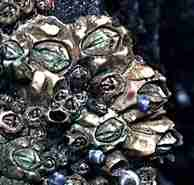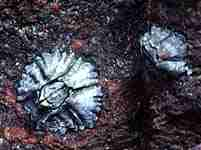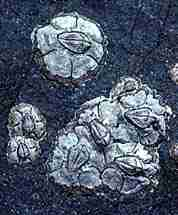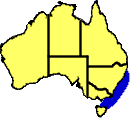|
|

Six-plated Barnacle Chthamalus antennatus
Form:
 The
Six-plated Barnacle is a medium-sized barnacle with six non-porous, main
shell plates. The sutures,
or divisions between the shell plates are easily seen. The opercular valve
(top middle plates) margins create an irregular shaped cross (see below).
The
Six-plated Barnacle is a medium-sized barnacle with six non-porous, main
shell plates. The sutures,
or divisions between the shell plates are easily seen. The opercular valve
(top middle plates) margins create an irregular shaped cross (see below).
See the distinctive shiny white "tooth-enamel" on the Six-plated Barnacles to the left. This is caused by weathering.
Question:
Why are these barnacles taller? Investigate why is this might be so?
 When
you look at the three examples of the Six-plated barnacle it is hard to
pick that they all belong to the one species. The amount of abrasion and
weathering or wearing from the environment has a lot to do with the appearance
of the shell.
When
you look at the three examples of the Six-plated barnacle it is hard to
pick that they all belong to the one species. The amount of abrasion and
weathering or wearing from the environment has a lot to do with the appearance
of the shell.
Mostly the Six-plated Barnacle looks like the specimens, to the above right. This is how they appear when they occur singly without there being intra-specific competition.
 If
the specimens are very heavily worn, then they will look like the those
to the left.
If
the specimens are very heavily worn, then they will look like the those
to the left.
Question:
Look for various barnacles in the environment, and see if you can work out why they look the way they do?
Colour:
The Six-plated Barnacle's exterior is dirty white to grey. On some, the shell tips have eroded, and this forms a small, shiny white area which has the appearance of tooth enamel.
Phylum: |
Mollusca |
Author: |
Darwin, 1854 |
Family: |
Chthamalidae |
Size: |
16-18 mm |
Distribution:
 The
Six-plated Barnacle ranges across New South Wales, eastern Victoria to
north-eastern Tasmania. They are restricted to south-eastern Australia.
The
Six-plated Barnacle ranges across New South Wales, eastern Victoria to
north-eastern Tasmania. They are restricted to south-eastern Australia.
Habitat:
It occurs at very high levels on the shore, often above mean high tide level. This means these highest barnacles may only be covered by water only a few times each month, and it is only then that it can feed. This may only be for a few hours every month.
Question:
How can an animal sustain itself when it only feeds for a very short period of time each month ?
Biology:
The Six-plated Barnacle is often found with the Honeycomb Barnacle, Chamaesipho tasmanica, which is usually smaller in size, and only have four main plates. Another common name is the Rough Barnacle.
References:
Bennett, I.(1987) Australian Seashores: W.J. Dakin's classic study, p. 247, Angus & Robertson.
Davey, K. (1989), A Photographic Guide to Seashore Life of Australia. p.40, New Holland.
Edgar, G. J. (1989) Australian Marine Life: the plants and animals of temperate waters. Reed.
Underwood, A. J. (1977), p. 11, Barnacles.
Marine Research Group of Victoria, (1984), Coastal Invertebrates of Victoria, p.105, The Museum of Victoria.
Surf
Barnacle
Six-plated Barnacle
Honeycomb Barnacle
Rose-coloured Barnacle
Rosette Barnacle
Giant Rock Barnacle
Home
Page
Taxonomy
Biogeography
Rocky Shores
Tidal Levels
Intertidal Zonation
Environmental Factors
Biological
Factors
Feeding Relationships
Activities
Glossary
References
 Life
on Australian Seashores
Life
on Australian Seashores
by Keith Davey (C) 2000
Learning Consultant
- Media
The University of Newcastle
email at australian_seashores@hotmail.com
Scientific Consultant: Phil
Colman
site created 01.01.98 : updated 01.04.2000